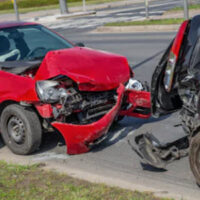Chain Reaction Collisions: Understand Some Basics

An auto accident can result in lost wages, thousands of medical bills, or car repairs, and, sometimes, a motorist’s PIP coverage may not be enough to cover them. In such a case, a motorist has the right to file a claim against the at-fault party’s insurance company. Establishing liability in an accident involving two cars can be an easy task. However, establishing fault in accidents involving more than two cars is usually a daunting task.
What Is a Chain Reaction Collision?
A chain reaction collision is an accident involving more than two vehicles. Such a collision is usually triggered by an initial impact originating from one of the vehicles. The vehicles involved in a chain reaction collision mostly hit each other in a series of rear-end collisions. Chain reaction accidents are often quite serious.
Here is an example of a chain-reaction collision.
Motorist 1 Motorist 2 Motorist 3 Motorist 4
Motorist 3 rear-ends the car in front (motorist 4). Motorist 2, who’s tailgating and cannot stop on time, then rear-ends the car in front (motorist 3). Because of that collision, and because motorist 1 is also tailgating, another rear-end collision happens when motorist 1 crashes into motorist 2. A scenario where motorist 4 rear-ends a vehicle is also possible if the force experienced after motorist 3 collides with motorist 4 sends motorist 4 forward into another vehicle in front. From this scenario, it is evident that chain reaction collisions can involve numerous cars.
Unfortunately, since most chain reaction collisions involve several motorists, who carry a percentage of blame, filing claims over such accidents can be complicated. Proving liability and negligence in a chain reaction collision can be a daunting task.
Proving Liability in a Chain Reaction Collision
In Florida, proving liability entails proving negligence. Tailgating is one of the negligent acts that cause chain reaction collisions but is not the only negligent act that can cause such an accident. Even over speeding can cause a chain reaction collision.
Regardless of the circumstances that lead to a chain reaction collision, victims of such collisions need to know that they can still file claims and obtain compensation from other drivers’ insurance companies as long as they can prove negligence. Nonetheless, you must keep in mind that Florida is a pure comparative negligence state. This means that if you played a part in causing the collision, your compensation stands to be deducted by the percentage of your fault.
Regardless of how a chain reaction collision accident plays out, you must have enough proof that can help you prove negligence on the side of another party. Things such as eyewitness accounts and police reports can help you prove negligence.
Legal Help Is Available After a Chain Reaction Collision
Chain reaction collisions are among the most complicated types of auto accidents. However, no matter how complex such an accident might appear, you can receive compensation for damages incurred. To increase your chances of obtaining compensation, you need to work with an experienced attorney. Our qualified Orlando personal injury attorneys can help you navigate the complexities of chain-reaction collisions and prove negligence. Our team can also help you understand how pure comparative negligence can affect your claim. Contact us today to schedule a free and no-obligation consultation.
The Pendas Law Firm also represents clients in the Jacksonville, Miami, Ocala, Daytona Beach, Tampa, Bradenton, Fort Myers, Fort Lauderdale, and West Palm Beach areas.
Resource:
flhsmv.gov/insurance/

